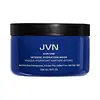What's inside
What's inside
 Key Ingredients
Key Ingredients

 Benefits
Benefits

 Concerns
Concerns

 Ingredients Side-by-side
Ingredients Side-by-side

Water
Skin ConditioningCetearyl Alcohol
EmollientCetyl Alcohol
EmollientSimmondsia Chinensis Seed Oil
EmollientBehentrimonium Chloride
PreservativePropylene Glycol
HumectantDimethicone
EmollientHippophae Rhamnoides Fruit/Seed Oil
AntimicrobialCetrimonium Chloride
AntimicrobialPanthenol
Skin ConditioningChlorphenesin
AntimicrobialTocopheryl Acetate
AntioxidantEthylhexylglycerin
Skin ConditioningBHT
AntioxidantPhenoxyethanol
PreservativeIsopropyl Alcohol
SolventCitric Acid
BufferingParfum
MaskingBenzyl Benzoate
AntimicrobialHydroxycitronellal
PerfumingLimonene
PerfumingWater, Cetearyl Alcohol, Cetyl Alcohol, Simmondsia Chinensis Seed Oil, Behentrimonium Chloride, Propylene Glycol, Dimethicone, Hippophae Rhamnoides Fruit/Seed Oil, Cetrimonium Chloride, Panthenol, Chlorphenesin, Tocopheryl Acetate, Ethylhexylglycerin, BHT, Phenoxyethanol, Isopropyl Alcohol, Citric Acid, Parfum, Benzyl Benzoate, Hydroxycitronellal, Limonene
Water
Skin ConditioningCetearyl Alcohol
EmollientCetyl Alcohol
EmollientSqualane
EmollientHydrogenated Farnesene
EmollientStearamidopropyl Dimethylamine
EmulsifyingCetyl Esters
EmollientCapryloyl Glycerin/Sebacic Acid Copolymer
Skin ConditioningDiheptyl Succinate
EmollientCitrus Aurantium Dulcis Fruit Extract
MaskingBehentrimonium Chloride
PreservativeHippophae Rhamnoides Oil
EmollientPanthenol
Skin ConditioningArginine
MaskingAspartic Acid
MaskingPCA
HumectantGlycine
BufferingAlanine
MaskingSerine
MaskingValine
MaskingIsoleucine
Skin ConditioningProline
Skin ConditioningThreonine
Histidine
HumectantPhenylalanine
MaskingLactic Acid
BufferingTocopherol
AntioxidantSodium Gluconate
Skin ConditioningLactobacillus Ferment
Skin ConditioningEthylhexylglycerin
Skin ConditioningSodium PCA
HumectantSodium Lactate
BufferingBenzyl Alcohol
PerfumingSodium Hydroxide
BufferingParfum
MaskingHexyl Cinnamal
PerfumingLinalool
PerfumingWater, Cetearyl Alcohol, Cetyl Alcohol, Squalane, Hydrogenated Farnesene, Stearamidopropyl Dimethylamine, Cetyl Esters, Capryloyl Glycerin/Sebacic Acid Copolymer, Diheptyl Succinate, Citrus Aurantium Dulcis Fruit Extract, Behentrimonium Chloride, Hippophae Rhamnoides Oil, Panthenol, Arginine, Aspartic Acid, PCA, Glycine, Alanine, Serine, Valine, Isoleucine, Proline, Threonine, Histidine, Phenylalanine, Lactic Acid, Tocopherol, Sodium Gluconate, Lactobacillus Ferment, Ethylhexylglycerin, Sodium PCA, Sodium Lactate, Benzyl Alcohol, Sodium Hydroxide, Parfum, Hexyl Cinnamal, Linalool
 Reviews
Reviews

Ingredients Explained
These ingredients are found in both products.
Ingredients higher up in an ingredient list are typically present in a larger amount.
This ingredient is a preservative and often used for it's anti-static properties. You'll most likely see this ingredient in hair conditioners.
It does not cause irritation or sensitization in leave-on products at 1-5%.
Cetearyl alcohol is a mixture of two fatty alcohols: cetyl alcohol and stearyl alcohol. It is mainly used as an emulsifier. Emulsifiers help prevent the separation of oils and products. Due to its composition, it can also be used to thicken a product or help create foam.
Cetearyl alcohol is an emollient. Emollients help soothe and hydrate the skin by trapping moisture.
Studies show Cetearyl alcohol is non-toxic and non-irritating. The FDA allows products labeled "alcohol-free" to have fatty alcohols.
This ingredient is usually derived from plant oils such as palm, vegetable, or coconut oils. There is debate on whether this ingredient will cause acne.
Due to the fatty acid base, this ingredient may not be Malassezia folliculitis safe.
Learn more about Cetearyl AlcoholCetyl Alcohol is a fatty alcohol. Fatty Alcohols are most often used as an emollient or to thicken a product.
Its main roles are:
Though it has "alcohol" in the name, it is not related to denatured alcohol or ethyl alcohol.
The FDA allows products labeled "alcohol-free" to have fatty alcohols.
Learn more about Cetyl AlcoholEthylhexylglycerin (we can't pronounce this either) is commonly used as a preservative and skin softener. It is derived from glyceryl.
You might see Ethylhexylglycerin often paired with other preservatives such as phenoxyethanol. Ethylhexylglycerin has been found to increase the effectiveness of these other preservatives.
Panthenol is a common ingredient that helps hydrate and soothe the skin. It is found naturally in our skin and hair.
There are two forms of panthenol: D and L.
D-panthenol is also known as dexpanthenol. Most cosmetics use dexpanthenol or a mixture of D and L-panthenol.
Panthenol is famous due to its ability to go deeper into the skin's layers. Using this ingredient has numerous pros (and no cons):
Like hyaluronic acid, panthenol is a humectant. Humectants are able to bind and hold large amounts of water to keep skin hydrated.
This ingredient works well for wound healing. It works by increasing tissue in the wound and helps close open wounds.
Once oxidized, panthenol converts to pantothenic acid. Panthothenic acid is found in all living cells.
This ingredient is also referred to as pro-vitamin B5.
Learn more about PanthenolParfum is a catch-all term for an ingredient or more that is used to give a scent to products.
Also called "fragrance", this ingredient can be a blend of hundreds of chemicals or plant oils. This means every product with "fragrance" or "parfum" in the ingredients list is a different mixture.
For instance, Habanolide is a proprietary trade name for a specific aroma chemical. When used as a fragrance ingredient in cosmetics, most aroma chemicals fall under the broad labeling category of “FRAGRANCE” or “PARFUM” according to EU and US regulations.
The term 'parfum' or 'fragrance' is not regulated in many countries. In many cases, it is up to the brand to define this term.
For instance, many brands choose to label themselves as "fragrance-free" because they are not using synthetic fragrances. However, their products may still contain ingredients such as essential oils that are considered a fragrance by INCI standards.
One example is Calendula flower extract. Calendula is an essential oil that still imparts a scent or 'fragrance'.
Depending on the blend, the ingredients in the mixture can cause allergies and sensitivities on the skin. Some ingredients that are known EU allergens include linalool and citronellol.
Parfum can also be used to mask or cover an unpleasant scent.
The bottom line is: not all fragrances/parfum/ingredients are created equally. If you are worried about fragrances, we recommend taking a closer look at an ingredient. And of course, we always recommend speaking with a professional.
Learn more about ParfumWater. It's the most common cosmetic ingredient of all. You'll usually see it at the top of ingredient lists, meaning that it makes up the largest part of the product.
So why is it so popular? Water most often acts as a solvent - this means that it helps dissolve other ingredients into the formulation.
You'll also recognize water as that liquid we all need to stay alive. If you see this, drink a glass of water. Stay hydrated!
Learn more about Water